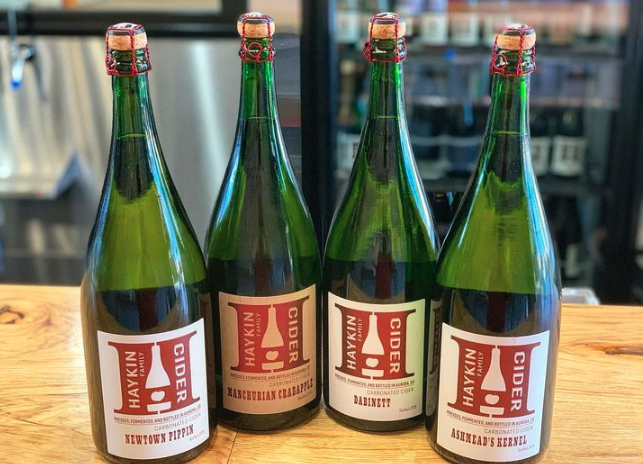
BOCO Cider / Instagram

Audio By Carbonatix
Whether it’s food, fashion or booze, there’s always a new trend. Some stick around for good and some are just a flash in the pan, but they all give us a new experience and something to talk about.
Cider is no exception, both nationally and here in Colorado. Patrick Combs, the director of liquids at Stem Ciders, says that cider makers are certainly exploring the boundaries. For a long time, he explains, cider was either really sweet and apple-focused with a very singular approach, or it was incredibly dry and funky. But now cider is stepping out of the box.
The strong craft beer culture in Colorado has an influence in the cider world as well. As Combs points out, a lot of people working in cider are transplants from the beer industry. “Consumers in Colorado are really open to trying things that are different and things that are a new take on something that they may have previously experienced,” he notes.
Perhaps the most obvious influence from the brew world is the addition of hops. St. Vrain Cidery in Longmont is doing a dry-hopped ginger cider with Mosaic hops; Boxing Brothers in Colorado Springs has a hazy apple double-hopped cider; Fenceline Cider in Mancos makes its Catkin with Hallertau Blanc and Hull Melon hops; and Boulder’s BOCO Cider has Native Haze, which is created with Hazy IPA yeast and hopped with Medusa, Zappa and Sabro hops.
Denver, make your New Year’s Resolution Count!
We’re $12,000 away from reaching our $50,000 year-end fundraising goal. Your support could be what pushes us over the top. If our work has kept you informed and connected this year, please consider making a contribution today.
Barrel-aged ciders are also on the rise. St. Vrain Cidery has a black spiced rum-barrel-aged dry cider, and Big B’s in Hotchkiss has Grizzly Brand, which is a bourbon-barrel-aged cider. Combs is excited for Stem’s barrel program, explaining that when you barrel-age a beer, it tends to get thicker and sweeter, but it doesn’t have the same impact on cider. “You know you’re drinking cider; it also happens to taste like a well-made Manhattan,” he notes.

Stem’s Lava Flow is inspired by Hawaiian cocktails.
Stem Ciders / Instagram
Barrel-aging overlaps with the next trend: cocktail-inspired ciders. Examples include George’s Whiskey Sour from WaldschÁ¤nke Ciders, Mojito from Locust Ciders in Lakewood and Peach Bellini from Boxing Brothers. Last year, Stem released a Manhattan and an Old Fashioned cider that Combs says was very well received. Most recently, it added three imperial ciders that are inspired by tropical cocktails: Rum Runner, Singapore Sling and Cobra’s Fang.
Kari Williams, cidermaker at Snow Capped Cider, says that tropical flavors in general are popular right now, especially pineapple, noting that the Cidercraft Magazine awards had so many entries using that flavor this year, they made a whole category just for the pineapple. One of the year-round offerings at Wild Cider in Longmont is Pineapple, while at St. Vrain, there is a seasonal Key Lime. At BOCO Cider, tropical fruit is front and center in its Passion cider made with passion fruit and its Mango Tango.
Like beer, more sessionable (low-alcohol) ciders along with low-calorie options are popping up. The Radl’ah Session Cider from Colorado Cider Company comes in at just 4.25 percent ABV. Stem offers Real Light, which has only 100 calories, 3 grams of carbohydrates, 1 gram of sugar, and is 4.6 percent ABV.
Stem also recently launched Carrot Ginger Turmeric as part of its botanical Leaves series, at just 4.2 percent ABV and 100 calories. “Botanical cider is on the rise again,” notes Williams. Other places to find botanical options include St. Vrain Cidery and Colorado Cider Company.

Haykin Family Cider / Instagram
Of course, there can’t be an exploration of cider trends without discussing the star of the show: the apples. Colorado Cider’s Brad Page says there’s a lot of buzz about traditional ciders from historic apple varieties.
Talia Haykin, co-owner of Haykin Family Cider in Aurora, adds, “One trend we have seen relating to heirloom apples is the increased transparency on the packaging.” She says it’s becoming more common for makers to clearly say what apples are in their cider and where they were grown.
Clear Fork Cider in Wheat Ridge, for example, notes that its Big Britches is a blend of Golden Russet, Winesap, Dabinett, Jonathan and Transcendent crab apples; all but the Dabinett are grown in the towns of Arriola and Crawford from 100-year-old trees.
Haykin’s ciders are each made with a single apple variety, and it’s clear where each comes from. Its semi-dry Jonathan, for example, is grown at Ela Family Farms in Hotchkiss, while the Newton Pippin comes from CiderView Orchards in Washington. “Our consumers know the names of our orchards, where they are, and the names and stories of the apples we ferment,” she explains. “This has shown us that providing the consumer with more information does work, and they embrace it, at least within the top-shelf placement of our industry.”
Snow Capped’s reserve ciders are single varietal as well; there’s Dabinett, Wickson Crab and Golden Russet, to name a few. The Crimson Gold from EsoTerra Ciderworks is another example; it uses only the Crimson Gold Applecrab variety, which is bright, complex and crisp, with floral notes.
As Colorado’s cider scene continues to grow, new trends surely will, too, as the state’s cider makers help to push the industry to new (delicious) levels.